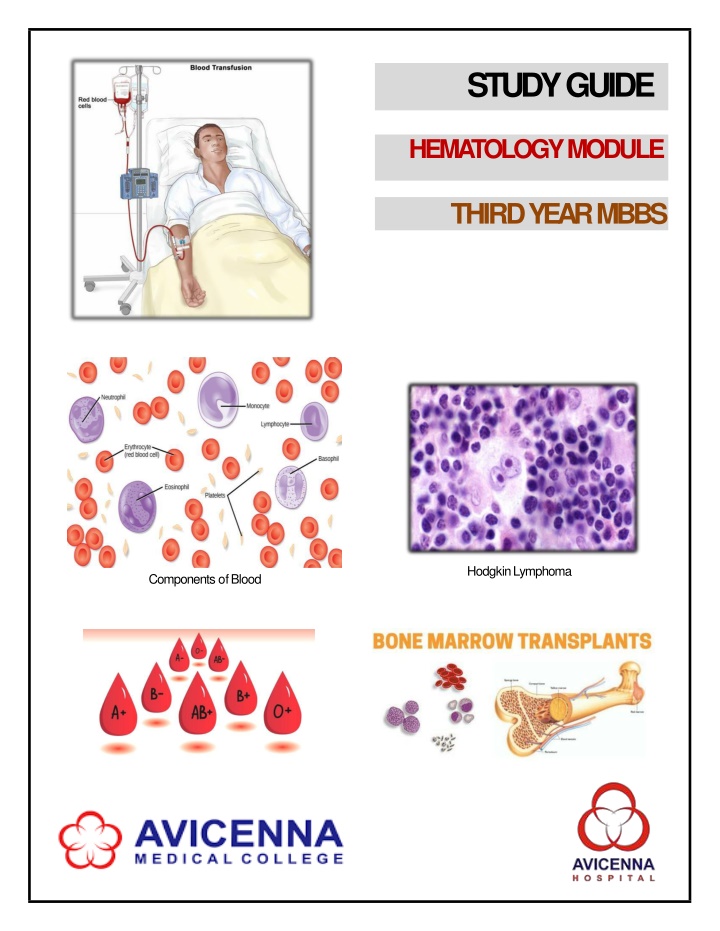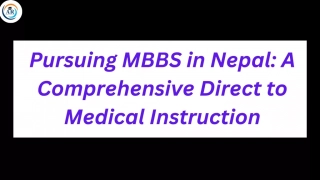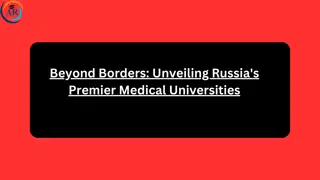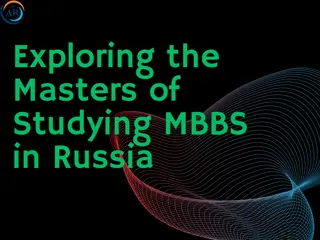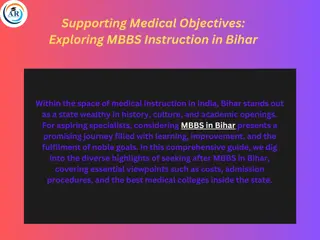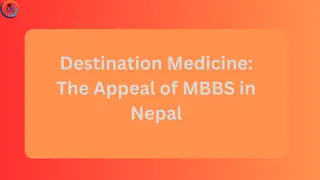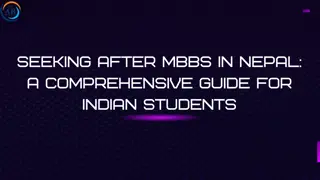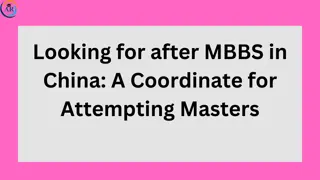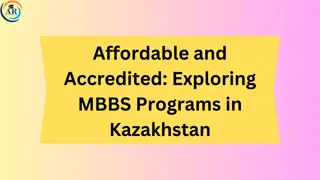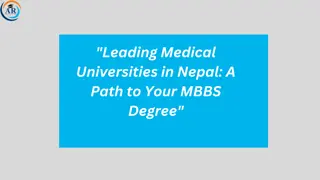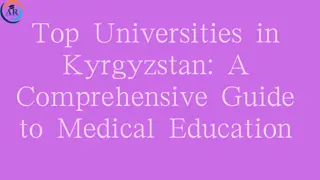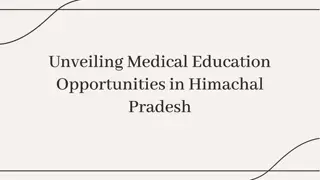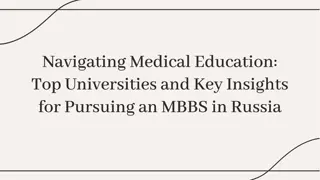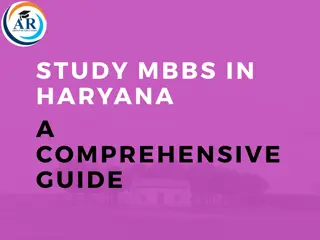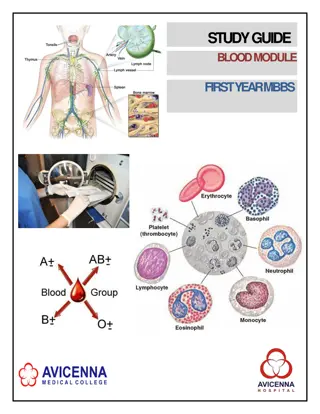Hematology Overview and Study Guide for Third Year MBBS Students
In the study guide for the Hematology module, students will find information on learning methodologies, objectives, assessment methods, rules, regulations, and curriculum framework. The curriculum focuses on integrated teaching, providing a holistic understanding of basic sciences in relation to clinical examples. Various learning experiences such as case-based discussions and practical demonstrations enhance student learning and skill acquisition.
Download Presentation

Please find below an Image/Link to download the presentation.
The content on the website is provided AS IS for your information and personal use only. It may not be sold, licensed, or shared on other websites without obtaining consent from the author.If you encounter any issues during the download, it is possible that the publisher has removed the file from their server.
You are allowed to download the files provided on this website for personal or commercial use, subject to the condition that they are used lawfully. All files are the property of their respective owners.
The content on the website is provided AS IS for your information and personal use only. It may not be sold, licensed, or shared on other websites without obtaining consent from the author.
E N D
Presentation Transcript
STUDYGUIDE HEMATOLOGYMODULE THIRD YEARMBBS HodgkinLymphoma Components ofBlood
3RD YEAR MBBS, HEMATOLOGYMODULE AVICENNA MEDICAL COLLEGE STUDY GUIDE FOR HEMA TOLOGYMODULE Page No. 3 4 5 7 7 8 15 17 19 20 CONTENTS S.No 1 2 3 4 4.1 4.2 5 6 7 9 Overview Introduction to StudyGuide LearningMethodologies Module 2:Hematology Introduction Objectives andStrategies LearningResources AssessmentMethods Modular Examination Rules and Regulations(AVMC) Schedule Page | 2
3RD YEAR MBBS, HEMATOLOGYMODULE AVICENNA MEDICAL COLLEGE Module name: Hematology Year: Three Duration: 4 weeks Timetable hours: Lectures, Case-Based Integrated Learning (CBIL), Clinical Rotations, learning experience in LNH outreach centers, Laboratory, Practical, Demonstrations, Skills, Self-Study Credit hours: 3 credit hours in theory and 1.5 credit hours in practical MODULE INTEGRA TED COMMITTEE MODULECOORDINATOR: CO-COORDINATORS: Professor Dr. Zubair Ahmad(Biochemistry) Professor Dr. Rubina Hafeez (Pathology) Professor Dr.Rehana Shahid(Anatomy) DEPARTMENTS & RESOURCE PERSONS FACILITA TINGLEARNING BASIC HEALTHSCIENCES CLINICAL AND ANCILLARYDEPARTMENTS FAMILYMEDICINE Professor Dr. Muhammad Luqman ANATOMY Professor Dr.Rehana Shahid BIOCHEMISTRY Professor Dr. Zubair Ahmad MEDICALEDUCATION Professor Dr. Waheed Ahmad COMMUNITYMEDICINE Professor Dr. Rana Muhammad Akhtar Khan INTERNALMEDICINE Dr. Muhammad Usman Amir PATHOLOGY Endocrinology Prof. Dr. Waheed Ahmed Professor Dr. Rubina Hafeez PHYSIOLOGY Professor Dr. Binyamin Ahmad PHARMACOLOGY Professor Dr. Rana Tariq Mehmood AVMCMANAGEMENT Professor Dr. Gulfreen Waheed, PrincipalAVMC Brig.Dr. Gul e Rana , Director AVMC Dr. Sadia Awan Dr. Muhammad Muzzammil Sadiq Dr. Usama Bin Ishtiaq STUDY GUIDE COMPILEDBY: Department of Health CareEducation Page | 3
3RD YEAR MBBS, HEMATOLOGYMODULE AVICENNA MEDICAL COLLEGE INTRODUCTION WHAT IS A STUDYGUIDE? It is an aidto: Inform students how student learning program of the semester-wise module has been organized Helpstudentsorganize andmanagetheirstudiesthroughoutthemodule Guide students on assessment methods, rules andregulations THE STUDYGUIDE: Communicates information on organization and management of themodule. Thiswill helpthestudentto contactthe rightpersonin caseof anydifficulty. Definestheobjectiveswhich areexpectedto beachieved at theendof themodule. Identifies the learning strategies such as lectures, small group teachings, clinical skills, demonstration, tutorial and casebasedlearning that will be implemented to achieve the module objectives. Provides a list of learning resources such as books, computer assisted learning programs, web- links,journals,forstudentsto consultin orderto maximize their learning. Highlights information on the contribution of continuous and semester examinations on the student s overallperformance. Includes information on the assessment methods that will be held to determine every student s achievement ofobjectives. Focuses on information pertaining toexamination policy, rules and regulations. CURRICULUMFRAMEWORK Studentswill experience integratedcurriculumsimilar to previousmodulesof all 4semesters. INTEGRATED CURRICULUM comprises of system-based modules such as Infectious Diseases, Hematology, Respiratory system-II and CVS-II which links basic science knowledge to clinical problems. Integrated teaching means that subjects are presented as a meaningful whole. Students will be able to havebetterunderstandingof basic scienceswhen they repeatedlylearn in relation to clinical examples. LEARNING EXPERIENCES: Case based Integrated discussions, skills acquisition in skills lab. Computer- based assignments, learning experiences in clinics, wards, and outreach centers Page | 4
3RD YEAR MBBS, HEMATOLOGYMODULE AVICENNA MEDICAL COLLEGE LEARNINGMETHODOLOGIES Thefollowing teaching/ learningmethodsareusedto promotebetterunderstanding: InteractiveLectures Small Group Discussion Case-Based Integrated Learning(CBIL) ClinicalExperiences o ClinicalRotations o Experience in LNH outreachcenters Practicals Skillssession Self-DirectedStudy INTERACTIVE LECTURE:In large group, the lecturer introduces a topic or common clinical conditions and explains the underlying phenomena through questions, pictures, videos of patients interviews, exercises, etc.Studentsareactively involved in the learningprocess. SMALLGROUPSESSION:This format helps students to clarify concepts acquire skills or attitudes. Sessions are structured with the help of specific exercises such as patient case, interviews or discussion topics. Students exchange opinions and apply knowledge gained from lectures, tutorials and self study. The facilitatorrole isto askprobing questions,summarize,orrephraseto helpclarify concepts. Page | 5
3RD YEAR MBBS, HEMATOLOGYMODULE AVICENNA MEDICAL COLLEGE CASE- BASEDINTEGRATED LEARNING (CBIL): A small group discussion format where learning is focused around a series of questions based on a clinical scenario. Students discuss and answer the questions applying relevant knowledge gained previously in clinical and basic health sciences during the module and construct new knowledge. The CBIL will be provided by the concern department. CBIL will be provided by the concerndepartment. CLINICALLEARNINGEXPERIENCES:In small groups, students observe patients with signs and symptoms in hospital wards, clinics and outreach centers. This helps students to relate knowledge of basic and clinical sciencesof the module andpreparefor futurepractice. CLINICALROTATIONS:In small groups, students rotate in different wards like Medicine, Pediatrics, o Surgery, Obs & Gyne, ENT, Eye, Family Medicine clinics, outreach centers & Community Medicine experiences. Here students observe patients, take histories and perform supervised clinical examinations in outpatient and inpatient settings. Theyalso get an opportunity to observe medical personnel working as a team. These rotations help students relate basic medical and clinical knowledgein diverse clinicalareas. EXPERIENCES IN LNH OUTREACH CENTERS: Learning at outreach centers of LNH have been o organized and incorporated as part of training of third year medical students. The objective of thesevisits isto provide clinical trainingexperiences for studentsin primarycaresettings. PRACTICAL: Basic science practicals related to pharmacology, microbiology, forensic medicine, and communitymedicine havebeenschedulefor studentlearning. SKILLSSESSION:Skills relevant to respective module are observed and practiced where applicable in skills laboratory. SELF DIRECTED STUDY: Students assume responsibilities of their own learning through individual study, sharing and discussing with peers, seeking information from Learning Resource Center, teachers and resource persons within and outside the college. Students can utilize the time within the college scheduled hoursofself-study. Page | 6
3RD YEAR MBBS, HEMATOLOGYMODULE AVICENNA MEDICAL COLLEGE SEMESTER 5 MODULE 2 :HEMA TOLOGY INTRODUCTION For MBBS third year students, the Hematology module concentrates on knowledge and skills required for diagnosis, and outlining the management plan of common hereditary, immunological, and neoplastic disorders of blood and its components. The module covers as well the principles and techniques of laboratory investigations essential for the diagnosis, and monitoring of the treatment of hematologicaldisorders. In view of prevalence in Pakistan, adequate coverage is given to different types of anemia, thalassemia, and other related disorders .Moreover, the objectives include blood transfusion and blood donation practices to promote safe transfusion, and appropriate use ofblood components. The Hematology module learning objectives take into consideration previously acquired pertinent knowledge in Blood module of MBBS first year. The module integrates with related disciplines such as Community Medicine, Family Medicine, Medicine, Oncology Pathology,Paediatrics, Pharmacology, and Physiology. It is expected that different learning experiences wouldhelp students build new knowledge, and enhance students understanding and motivation toseek further knowledge. Page | 7
3RD YEAR MBBS, HEMATOLOGYMODULE AVICENNA MEDICAL COLLEGE COURSE TOPICS, OBJECTIVES AND TEACHINGSTRA TEGIES TEACHING STRATEGY At theendof themodulethestudentswill beableto: OBJECTIVES FACULTY History Taking & Counseling Obtain a comprehensive history of a patient presenting with symptoms ofanemia Perform general physical examination related to anemia (conjunctiva, tongue and nails forpallor, nail examination forkoilonychias) Counsel patients with regards to supplementation and dietary modification in nutritional anemia (iron,B12 and folate) Demonstrate steps of counseling onsimulator RBCs SmallGroup Discussion FamilyMedicine Interactive Lecture/SmallGroup Discussion Discuss steps of normal haemopoiesis with importanceof red cell indices and itscorrelation Physiology Anemias & Hemoglobinopathies Interactive Lecture/SmallGroup Discussion Discuss the physiology of anemia (nutritional),the importance ofred cell indices and its correlation Physiology Classify anemia based onMCV Describe blood lossanemia Pathology InteractiveLecture Describe the clinical presentation of various types of anemia by age and gender such as iron deficiency anemia, hemolytic anemia, Thalassemia, megaloblastic anemia, anemia of chronicdisease Interactive Lecture/Case- Based Learning FamilyMedicine Interpret CBC and peripheral smear findings inmicrocytic, normocytic and macrocyticanemia Discuss the causes of low and high reticulocyticcount Small Group Discussion/Practic al Pathology Define the pathogenesis ofunder production anemias Describe nutritional anemia and their metabolicpathways Differentiatenutritionalanemiasontheir clinical features Differentiate the morphological spectrum ofvarious nutritionalanemias Differentiate between iron and megaloblastic anemia, based on etiology and clinicolaboratory diagnosticfeatures Pathology InteractiveLecture Page | 8
3RD YEAR MBBS, HEMATOLOGYMODULE AVICENNA MEDICAL COLLEGE Describe aplastic anemia, its pathophysiology, etiology and clinical course along with diagnostic and morphological features Define pathogenesis of Anemia of Chronic diseaseand Chronic Renalfailure Classify hemolytic anemia Classify and identify intracorpusculardefects Identify sickle cell anemia, hereditary spherocytosisand G6PD deficiency based on etiology, pathophysiology , clinical features and laboratoryworkup Differentiate between intravascular and extravascular hemolysis Pathology Pathology Differentiate between immune and non immune hemolytic anemias, based on clinical and laboratory parameters. Identify and describe extracorpusculardefects Pathology Definethalassemia Describe two generaltypesof thalassemiaincluding the defects ofeach Describe thefourtypesof alphathalassemia including the defects ofeach Molecula r Patholog y InteractiveLectures Discuss the symptomatology , diagnosis and differential diagnosisof: o Thalassemia o Sickle cellanemia o Hereditary spherocytosis o G6PDdeficiency o Pyruvate kinasedeficiency o Acquired hemolytic anemia o Autoimmune hemolytic anemia Pediatrics Describe the relevant investigations for diagnosis of anemia which includes iron deficiency anemia, Thalessemia, megaloblastic anemia, anemia associated with chronic disease and hemolyticanemia) FamilyMedicine WBCs Distinguish between leucopenia, neutropenia and agranulocytosis Discuss the pathogenesis of reactive proliferationof white bloodcells Enumerate the pathogenesis of neutropeniaand agranulocytosis Pathology InteractiveLectures Page | 9
3RD YEAR MBBS, HEMATOLOGYMODULE AVICENNA MEDICAL COLLEGE Describe leukemoid reaction, leucoerythroblastic picture and itscauses Identify acute and chronic infections, along withits pathogenesis andmorphology Differentiate between normal white cell andabnormal WBC conditions based onmorphology Differentiate between normal and abnormal bonemarrow examinationfindings Small Group Discussion Discuss the types and groups ofimmunomodulating agents, Explain the diseases in which immunostimulation and suppression isrequired State the rationale ofimmunomodulants use Discuss the clinical uses of immunostimulants and suppressants Pharmacology InteractiveLecture Leukemia & Lymphoma Classify neoplastic proliferation of white cells based on WHO classification myeloid/ lymphoid neoplasm and acute leukemias Differentiate between chronic leukemia andacute leukemia Pathology Discuss clinical presentation, differential diagnosis, investigation and management of a patient withLeukemia Oncology InteractiveLectures Describe myelodysplastic syndrome, its types, clinical features, morphology andprognosis Identify different myeloproliferative disorders, their pathogenesis, hematological features, clinical behavior and disease outcome Pathology Differentiate between normal white cells, Leukemoid reaction and malignant cell based on microscopicfeatures Describe the tools used to establish diagnosis,determine prognosis and clinical management oflymphoma Oncology Explain the role of Molecular Diagnostics in Hematopoetic malignances Explain methods of molecular diagnostics and theirutilities Analyze and evaluate different MolecularPathology Diagnostic reports Interactive Lecture/Video - based teaching Molecula r Patholog y Page | 10
3RD YEAR MBBS, HEMATOLOGYMODULE AVICENNA MEDICAL COLLEGE Discriminate between Hodgkin s and nonHodgkin lymphomas Identify low grade and high gradelymphomas Interpret various types of lymphoma based on its pathogenesis morphology, clinical sign andsymptoms, immunophenotyping, cytogenetics andprognosis Describe various types of non-Hodgkin lymphoma,their morphology and clinicalcourse Pathology InteractiveLecture Transplantation Describe BMT and classify its types Explain the indications and common complications of transplant Pathology InteractiveLectures Discuss the immunology basis of transplantrejection Describe Graft versus host disease(GVHS) Platelets & BloodCoagulation InteractiveLecture /SmallGroup Discussion Explain the physiological pathway ofhemostasis Explain the extrinsic and intrinsic pathways ofcoagulation Physiology DiscussHemostasis Evaluate clotting disorders inchildren Explain Hemophilia Discuss the treatment options for coagulationdisorders Pediatrics InteractiveLectures Describe signs & symptoms, differential diagnosis, investigation of patients suffering from coagulation disorders as well as for Thrombocytopenia Medicine Describe andinterpret the approachto apatient with bleeding disorders basedon history, examination and investigation Delineate the diagnostic approach in bleedingdiathesis, emphasis on Von-willebrand andhemophilia Medicine InteractiveLecture Discuss first and second line investigations in a bleeding patient Interpretfirstline investigationsfor patient with bleeding disorder Describe the signs and symptoms ofdisseminated intravascular coagulation(DIC) Identify management modalities fordisseminated intravascular coagulation(DIC) Discuss strategies for anticoagulation and itscomplications SmallGroup Discussion Pathology Medicine InteractiveLecture Page | 11
3RD YEAR MBBS, HEMATOLOGYMODULE AVICENNA MEDICAL COLLEGE Blood Grouping & Transfusion Explain feto-maternal blood groupincompatibility Discuss the evaluation, management and preventionof hemolytic disease innewborn Pediatrics Describe the Blood grouping based on ABO & Rhsystems Explain the blood componentstherapy Discuss the indication & contraindications oftransfusion Describe the basics of crossmatch InteractiveLectures Pathology Classify adverse transfusion reactions both immediateand delayedtypes Dyslipidemia Enumeratethetypesof dyslipidemias andthe protocolof theirmanagement Explain the dynamics and kinetics of different drugs forthe treatment ofdyslipidemias SmallGroup Discussion Pharmacology Vasoactive Peptides & Serotinin Classify the vasoactivepeptides Discuss the clinical importance and properties ofdifferent vasoactive peptides Describe the basic and clinical pharmacology ofvasoactive peptides Explain the mechanism of action, therapeuticuses , adverse effects, and contraindications of serotonin agonists andantagonists Discussthe role of serotonin,itsagonistandantagonistsin different clinicalconditions. Discuss the clinical aspects of serotonin agonistsand antagonists InjectionTechniques Demonstrate different injection technique onthe mannequin SmallGroup Discussion Pharmacology Demonstration& Hans-On Skills Lab CancerEpidemiology Describe the distribution of various types of cancer prevalent globally including Pakistan and preventive measures Discuss the role and inter-disciplinary methods ofcancer control andprevention Communit y Medicine InteractiveLecture Page | 12
3RD YEAR MBBS, HEMATOLOGYMODULE A VICENNA MEDICA L COLLEGE Vaccines & VaccinesSchedule Explain different types of vaccines, and their safeand effective use for prevention of infectiousdiseases Communit y Medicine InteractiveLectures Discussthe typesof immunity andvaccineswith coldchain Expanded Program on Immunization (EPI) Discuss the provision ofthe quality immunization services and its schedule (EPI) that promote, protect and preserve the children of Pakistan against the vaccine preventable diseases Communit y Medicine InteractiveLecture School HealthServices Describe various components of school healthprogram, and their functions for health promotion of the school children / students Describe how community and school policies protectthe health, welfare, and safety ofstudents. Communit y Medicine InteractiveLecture PersonalIdentity Explain personalidentity Describe the parameters ofidentification Explain circumstances where issues of Identification arise Describe medico-legal significance of age, gender andrace InteractiveLecture ForensicMedicine Discuss estimation of age and certification ofan individual on medical examination of physique, teeth (dental) and radiology Small Group Discussion/ Demonstratio n InteractiveLecture ExplaintheImportanceofBloodGroupinginParental Dispute Fixation of the Individuality in Living & Dead Discuss biometric system, dactylography (fingerprints), birth marks, deformities, hair, scars, tattoomarks InteractiveLecture ForensicMedicine Small Group Discussion/ Demonstratio n Determination of gender from bones/osteometericindices TraceEvidence Describe Locard s exchange principle and Traceevidence in connection of crimereconstruction Identificationindisputedpaternity andmaternitycases ForensicMedicine InteractiveLecture Page | 13
3RD YEAR MBBS, HEMATOLOGYMODULE AVICENNA MEDICAL COLLEGE Small group Discussion/ Demonstratio n Discuss the biometrics, DNA and fingerprints Medicolegal Aspects of Death(Thanatology) Define death and braindeath Identifytheconditionsandcriteriaof braindeath Define suspended animation along withexamples List Howard s criteria ofdeath Identifydifferentmethodsusedintheestimationoftime sincedeath Define sudden and unexpecteddeaths Describe immediate signs of death with special stresson somatic and clinical death Classify and describe postmortem bodily changes accordingto thetimeof onset Discuss putrefication, its mechanisms, changes and gases of decomposition Estimate postmortem intervals based on knowledgeabout forensicentomology Explain adipocere formation andmummification Discuss Cause-Mechanism-Mode and Manner ofdeath Explain presumption of death and presumptionof survivorship InteractiveLectures ForensicMedicine Small Group Discussion Explain death certificate as recommended byW.H.O Apart from attending daily scheduled sessions, students too should engage in self-study to ensure that all the objectives arecovered Page | 14
3RD YEAR MBBS, HEMATOLOGYMODULE AVICENNA MEDICAL COLLEGE LEARNINGRESOURCES SUBJECT RESOURCES TEXTBOOKS 1. Preventive and Social Medicine by KPark 2. Community Medicine by MIllyas 3. Basic Statistics for the Health Sciences by Jan WKuzma COMMUNITYMEDICINE TEXTBOOKS 1. Nasib R. Awan. Principles and practice of Forensic Medicine 1st ed.2002. 2. Parikh, C.K. Parikh s Textbook of Medical Jurisprudence,Forensic Medicine and Toxicology. 7thed.2005. REFERENCEBOOKS 3. Knight B. Simpson s Forensic Medicine. 11th ed.1993. 4. Knight and Pekka. Principles of forensic medicine. 3rd ed.2004 5. Krishan VIJ. Text book of forensic medicine and toxicology (principles and practice). 4th ed.2007 6. Dikshit P.C. Text book of forensic medicine and toxicology. 1st ed.2010 7. Polson. Polson s Essential of Forensic Medicine. 4thedition. 2010. 8. Rao. Atlas of Forensic Medicine (latestedition). 9. Rao.Practical Forensic Medicine 3rd ed,2007. 10. Knight: Jimpson s Forensic Medicine 10th 1991,11thed.1993 11. Taylor s Principles and Practice of Medical Jurisprudence.15th ed.1999 CDs: 1. Lectures on ForensicMedicine. 2. Atlas of ForensicMedicine. FORENSICMEDICINE WEBSITES: www.forensicmedicine.co.uk REFERENCEBOOKS: 1. Hutchison s Clinical Methods, 23rdEdition 2. MacLeod's clinical examination 13thedition 3. Davidson's Principles and Practice ofMedicine 4. Kumar and Clark's ClinicalMedicine 5. HCAI guidelines CDC 6. WHO TBguidelines GENERALMEDICINE TEXTBOOKS 1. Robbins & Cotran, Pathologic Basis of Disease, 9thedition. 2. Rapid Review Pathology, 4th edition by Edward F. GoljanMD PATHOLOGY/MICROBIOLOGY WEBSITES: 1. http://www.hematology.org/Educators/High-School.aspx#a2 2. http://imagebank.hematology.org/ Page | 15
3RD YEAR MBBS, HEMATOLOGYMODULE AVICENNA MEDICAL COLLEGE TEXTBOOK: 1. Textbook of Pediatrics by PPA, preface written by S. M.Haneef 2. Basis of Pediatrics (8th Edition Pervez Akbar) PEDIATRICS A. TEXTBOOKS 1. Lippincot IllustratedPharmacology 2. Basic and Clinical Pharmacology by Katzung PHARMACOLOGY ADDITIONAL LEARNINGRESOURCES Hands-on Activities/PracticalStudents will be involved in Practical sessions and hands-on activitiesthat link with the hematologymoduleto enhancethelearning. Utilize thelabto relatetheknowledge to the specimensandmodels Labs available. A skills lab provides the simulators to learn thebasic skills and procedures. This helps build the confidence toapproach the patients. SkillsLab https://opentextbc.ca/clinicalskills/chapter/6-8-iv-push-medications-and- saline-lock-flush/ Video familiarize the student with the proceduresandprotocols to assist Videos patients. To increase the knowledge students should utilize the available internet resources and CDs/DVDs. This will be an additional advantage to increase Computer Lab/CDs/DVDs/Internet learning. Resources: Self Learning is scheduled to search for information to solve cases,read through different resources and discuss among the peers and with the SelfLearning faculty to clarify theconcepts. Page | 16
3RD YEAR MBBS, HEMATOLOGYMODULE AVICENNA MEDICAL COLLEGE ASSESSMENTMETHODS: Theory: o Best Choice Questions (BCQs) also known as MCQs (Multiple Choice Questions) are used to asses objectives covered in eachmodule. A BCQ has a statement or clinical scenario followed by four options (likelyanswer). Students after reading the statement/scenario select ONE, the most appropriate response from the given list ofoptions. Correct answer carries one mark, and incorrect zero mark . There is no negative marking. Studentsmarktheirresponsesonspecifiedcomputer-based/OMRsheetdesignedforAVMC OSPE/OSCE: Objective Structured Practical/ClinicalExamination: Eachstudentwill beassessedonthe samecontentandhavesametimeto completethe task. Comprise of 12-25stations. Each station may assess a variety of clinical tasks, these tasks may include history taking, physical examination, skills and application of skills andknowledge Stations are observed, unobserved, interactive and reststations. Observed and interactive stations will be assessed by internal orexternal examiners. Unobserved will be static stations in which there may be an X-ray, Labs reports, pictures, clinical scenarioswith relatedquestionsforstudentstoanswer. Rest station is a station where there is no task given and in this time student can organize his/her thoughts. InternalEvaluation Students will beassessedto determine achievement of moduleobjectivesthroughthefollowing: Module Examination: will be scheduled on completion of each module. The method of o examination comprises theory exam which includes BCQs and OSPE (Objective Structured Practical Examination). Graded Assessment of students by Individual Department: Quiz, viva, practical, assignment, small o group activities such as CBL, TBL, TOL, online assessment, ward activities, examination, and log book. Marksof bothmodular examinationandgradedassessmentwill constitute 20%weightage. As per UHS policy, this 20% will be added by UHS to SemesterExamination. Page | 17
3RD YEAR MBBS, HEMATOLOGYMODULE AVICENNA MEDICAL COLLEGE Example : Number of Marks allocated for Semester Theory and Internal Evaluation InternalEvaluation (Class test +Assignments + Modular Exam) 20% Semester Examination TheoryMarks Total(Theory) Semester 80% 100% FormativeAssessment Individual department may hold quiz or short answer questions to help students assess their own learning. The marks obtained are not included in the internalevaluation More than 75% attendance is needed to sit for the modular and semester examinations Page | 18
3RD YEAR MBBS, HEMATOLOGYMODULE AVICENNA MEDICAL COLLEGE MODULAR EXAMINATION RULES & REGULATIONS(AVMC) Studentmustreportto examinationhall/venue, 30 minutesbeforetheexam. Exam will begin sharp at the giventime. No student will be allowed to enter the examination hall after 15 minutes of scheduled examinationtime. Studentsmustsitaccordingto theirroll numbersmentioned ontheseats. Cell phones are strictly not allowed in examinationhall. If anystudentisfoundwith cell phonein anymode(silent, switchedoff oron)he/shewill benot be allowed to continue theirexam. No students will be allowed to sit in exam without University Admit Card, AVMC College ID Card and LabCoat Student must bring the following stationary items for the exam: Pen, Pencil, Eraser, and Sharpener. Indiscipline in the exam hall/venue is not acceptable. Students must not possess any written materialorcommunicatewith theirfellowstudents. UHSGradingSystem It will be based on GPA 4system Marks obtained in Percentagerange NumericalGrade AlphabeticalGrade 80-100 4.0 A+ 75-79 4.0 A 70-74 3.7 A- 67-69 3.3 B+ 63-66 3.0 B 60-62 2.7 B- 56-59 2.3 C+ 50-55 2.0 C <50 Un-grade-able 0 U A candidate obtaining GPA less than 2.00 (50%) is declared un-graded(fail). Cumulativetranscriptisissuedat the endof clearance of all modules. Page | 19
